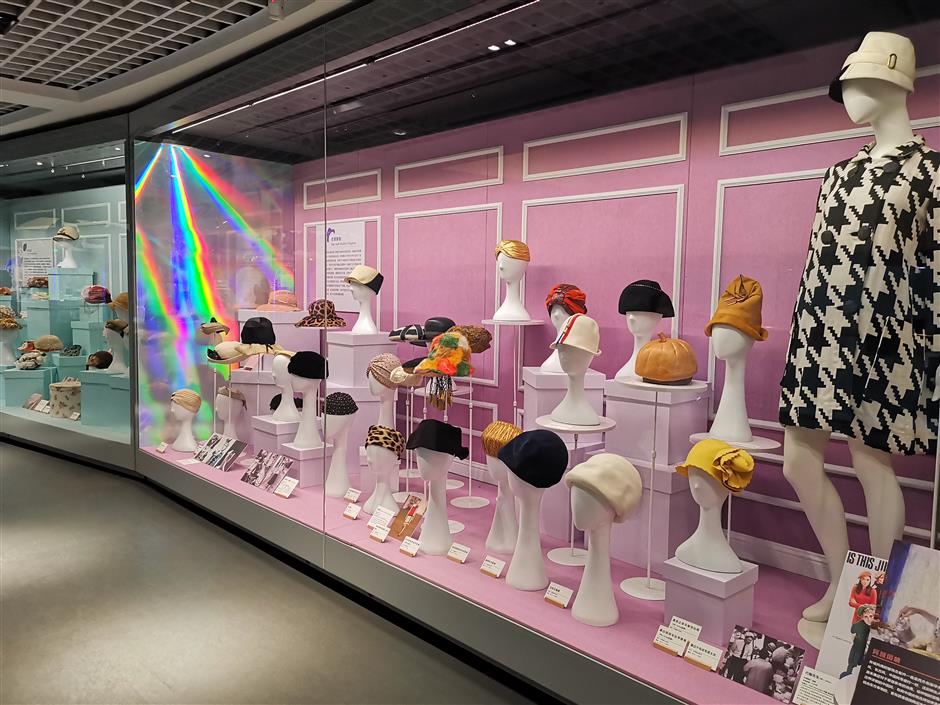Hats and garments displayed to charter fashion's evolution throughout history
As China's leading organization researching ancient textiles and modern fashion designs, the China National Silk Museum has displayed more than 5,000 garments and fabrics in cooperation with domestic art organizations over the past 10 years.
Now, two ongoing exhibitions, cosponsored by the China Academy of Art, feature 114 garments and 150 vintage hats, providing visitors with a well-rounded picture of how the fashion industry developed throughout history.
"This year, the museum will initiate a new exhibition mode that integrates the fashion industry with embroidery. The focus is displaying the embroidered exhibits to explore the practice of old handicraft on modern-day designs," said Chen Baichao, curator of the two exhibitions. "Along with the rise of guochao – a movement that celebrates Chinese designers' focus on Chinese culture and the changing fashion market – we hope more domestic brands turn the traditional craft into avant-garde designs. That is a type of sustainable development in the long term."
Dresses in the first exhibition are on loan from over 70 designers, embroiders and organizations, displaying invigorated Chinese embroidery and the potential market for the time-honored craft.

A range of hats
Some works were inspired by Chinese ink-wash paintings and poetry that embody the peaceful inner world of ancient literati.
Xiong Ying, founder of the domestic brand Heaven Gaia, drew inspiration from "The Classic of Poetry," or "Shijing." As the oldest existing collection of Chinese poems, it contains eulogies and hymns in homage to herbs and flowers.
Xiong designed the dresses with layers of gauze embroidered with sophisticated herbal patterns. When models wearing the dresses strut down runways, the gauze rises up in the air.
A Chinese imperial-style gown designed by Zhang Yahua features phoenix motifs and ornate peony patterns as well as traditional auspicious clouds. Such patterns were exclusive for empresses since they represented supremacy in ancient times.
Now, such an ornate dress is commonly seen at weddings. Chinese brides prefer wearing a phoenix-embroidered ceremonial wedding dress rather than a contemporary Western garment.

Traditional golden and red Chinese wedding dresses with ornamental phoenix patterns are on show.
A dress designed by Guo Pei is emblematic of this phenomenon.
As a famous haute couture designer popular with Chinese actresses, Guo adapted an ancient Chinese wedding gown to design a dress featuring phoenix tail-shaped hems, a nipped-in waist emphasizing the woman's body curves and a full skirt extending below the ankles.
Compared with ordinary embroidery styles in the Yangtze River Delta region, the embroidered patterns from Ma Yanli's designs use brightly hued thread and brocade from the Yi ethnic minority, distinguished by outlines in red and white threads.
She has referred to ethnic minority culture for inspiration and added modern aesthetics and trendy elements to a series of dresses to present vibrant lifestyles of the new era.

Ma Yanli's designs
Silk has always been a conventional fabric fit for embroidery. It features light and breathable properties often used in summer apparel. Today, pricy silk is still popular among consumers from home and abroad.
In southern China's Guangdong Province, there is a variety of transparent silk considered high end that people call "aromatic cloud." The glitzy gauze is also called "soft gold" thanks to its time-consuming manufacturing process, high price and limited production. Du Qingnan used the gauze to design a qipao sewn with golden patterns.
The second exhibition displays vintage hats from Western countries during the 19th and 20th centuries when hats played a pivotal role in people's outfits. During that era, hats had social meaning beyond keeping people's heads warm. Especially for women, an exquisite hat often symbolized her social status and wealth.
Extravagant decorations including artificial flowers, feathers and ribbons adorned hats in that era. This luxurious style permeated Europe's upper society.
Feathers have long been used in designing hats. However, the 19th and early 20th centuries saw feathers even more commonly used since manufacturing skills peaked at the time.

Feather hats
However, the situation greatly changed when World War I broke out. Such extravagant style gradually decreased since women started to pursue independence and liberation under the influence of Art Nouveau.
A kind of fitted, bell-shaped cloche hat was created in 1908, with its name derived from the French word for "bell."
The popularity and influence of cloche hats was at its peak during the early 20th century. Many haute couture designers began producing cloche hats that precisely matched their clothing designs.
Cloches could be made of beads or laces for evening wear, dancing and even bridal wear. Women often wore the hats low on their foreheads, with their eyes only slightly below the brim.
The exhibition also includes hats that epitomized social status for men.

Bell-shaped cloche hats are on display. The hats were popular during the early 20th century.
'Fashion in Hats' Western Fashion Hat of the 19th and 20th Centuries
Date: Through March 24
'Vision' Global Qipao Invitational Exhibition
Date: Through October 1
Venue: China National Silk Museum
Address: 73-1 Yuhuangshan Rd
玉皇山路73-1号
















